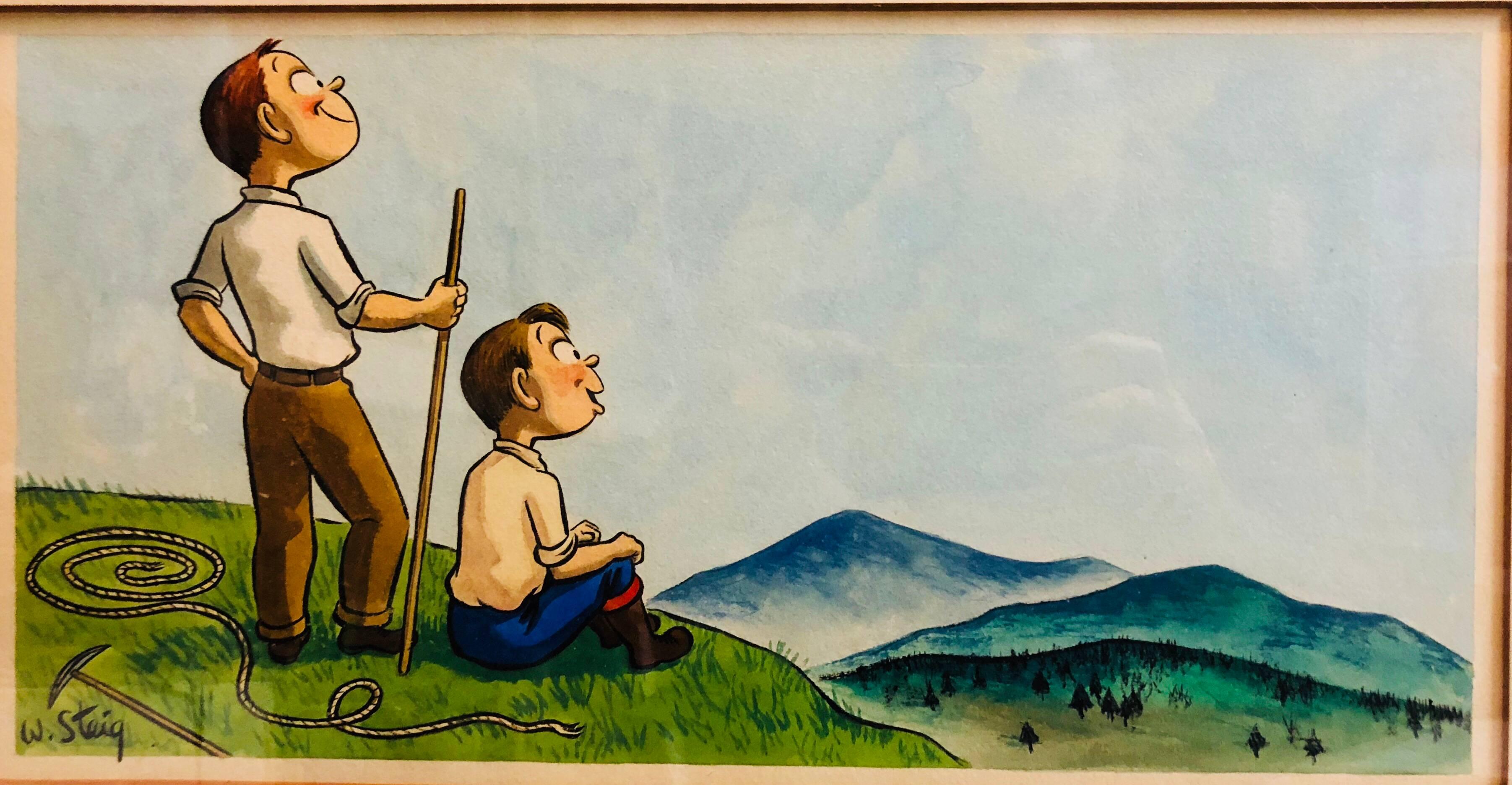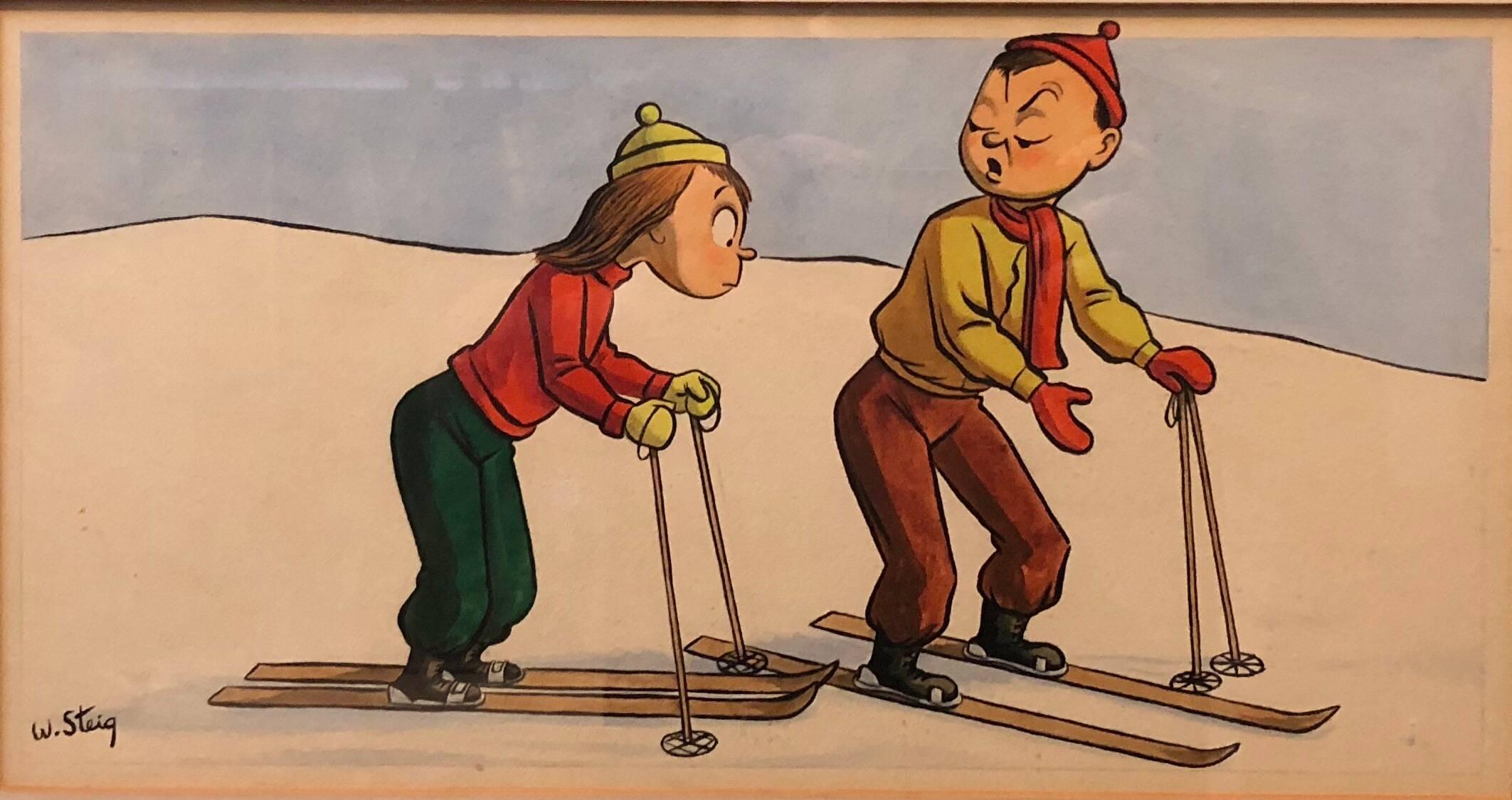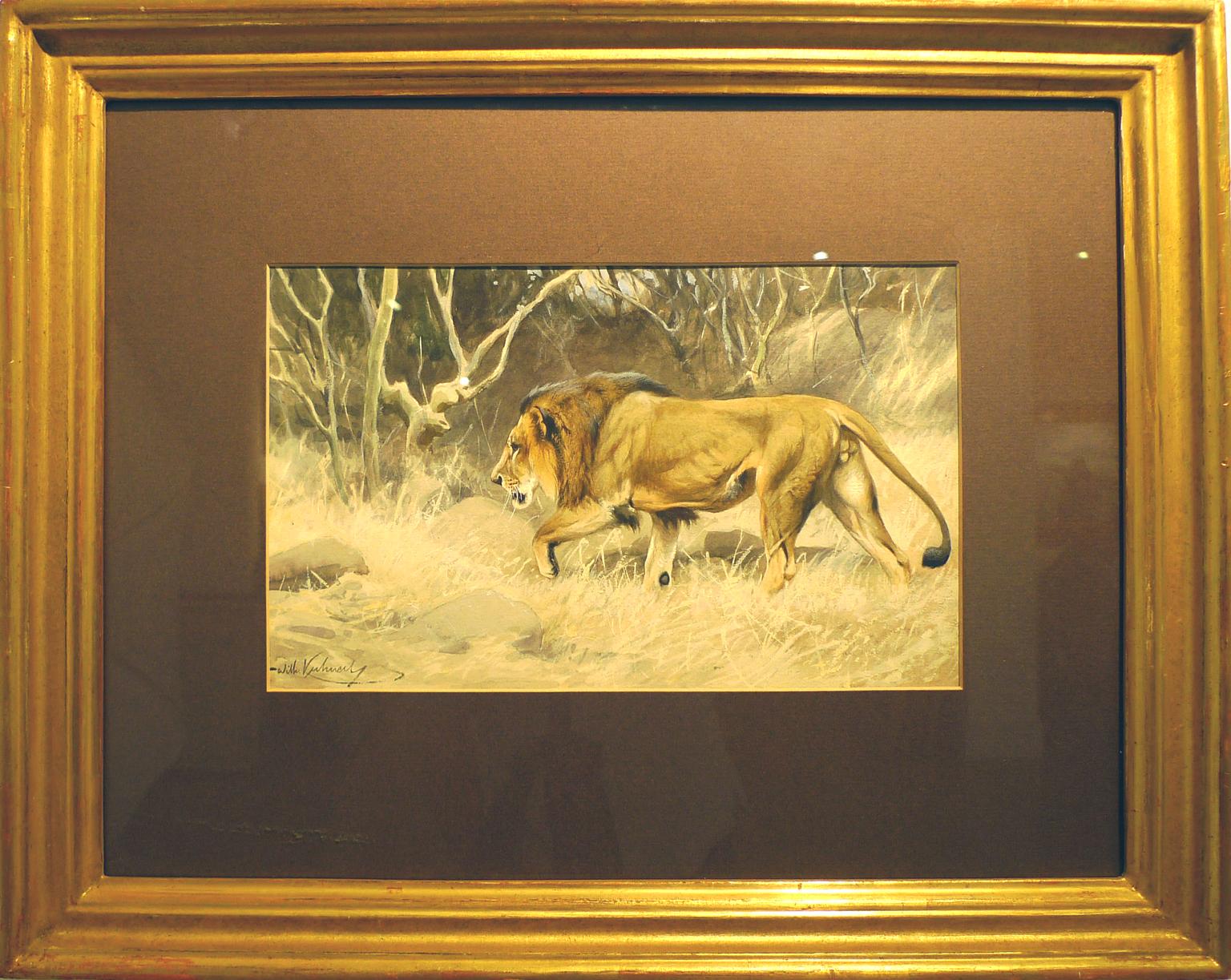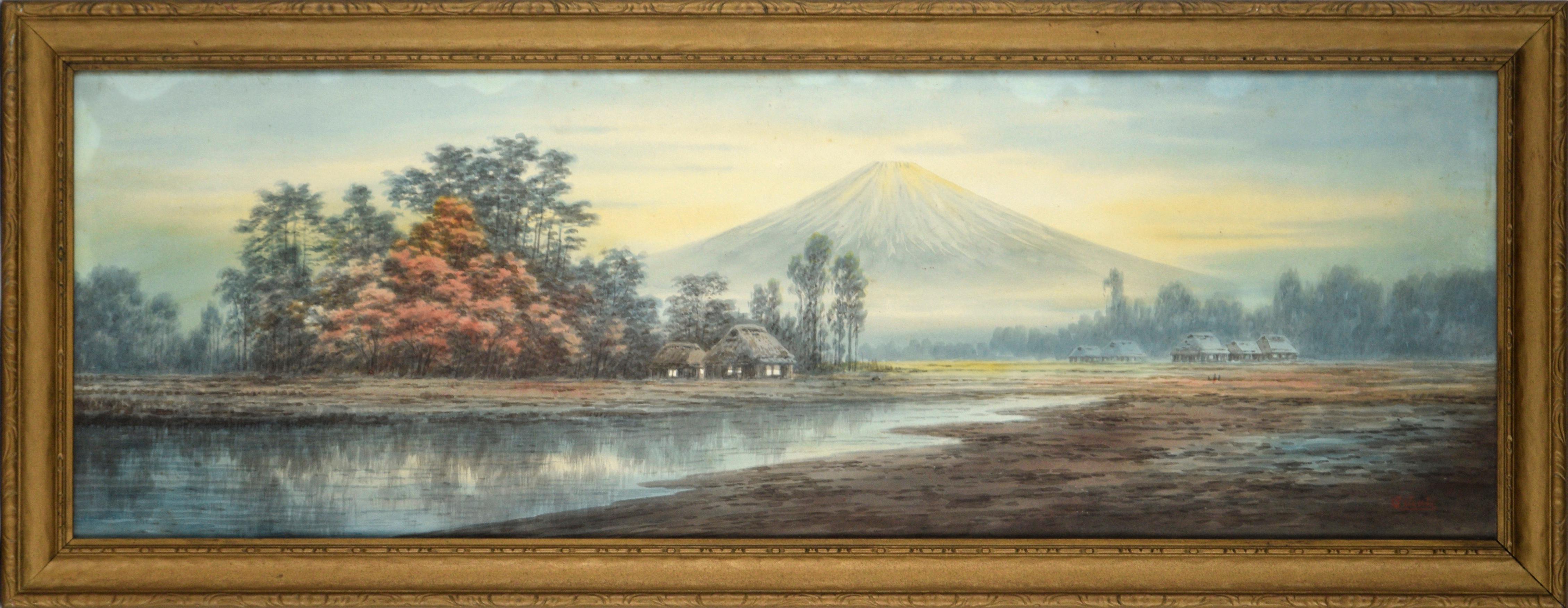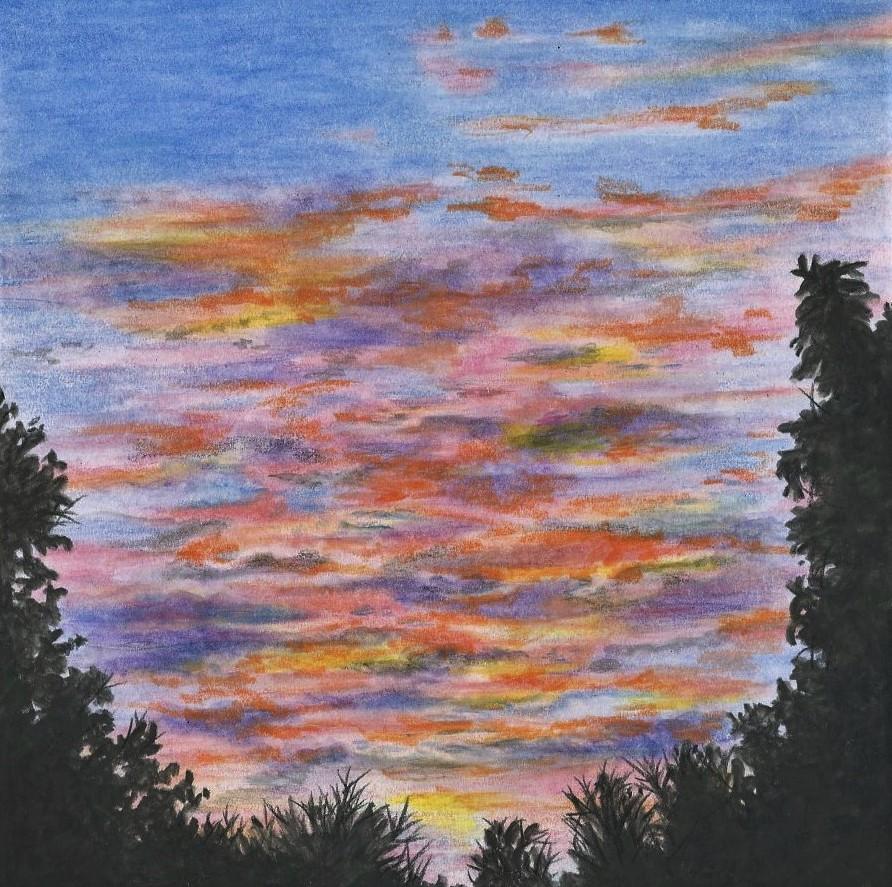Items Similar to Beneath the Birch Drawing by Swedish Artist Christian Berg (1893–1976)
Want more images or videos?
Request additional images or videos from the seller
1 of 12
Christian BergBeneath the Birch Drawing by Swedish Artist Christian Berg (1893–1976)1920s
1920s
About the Item
We are proud to present an exquisite drawing by the renowned artist Christian Berg (1893-1976), executed around the 1920s. This captivating artwork portrays a landscape, showcasing the artist's remarkable talent and attention to detail.
The focal point of the composition rests on the left, where a solitary leafless birch tree gracefully extends its branches across the entire expanse of the sky. The artist's meticulous rendering of the intricate branch structure is truly awe-inspiring, displaying an impressive level of detail and precision.
To the right of the birch tree, some water comes into view and behind the birch tree, several spruce trees emerge, their forms delicately captured with green watercolor strokes. The surrounding ground, adorned with a lush green wash, seamlessly integrates with the natural environment of the trees.
In the background, the artist employs the soft hues of watercolor to depict distant, misty mountains. The bluish tones create a sense of depth, enhancing the overall serenity and vastness of the scene.
"My sculptural work is an expression of what captivates and engages me, whether it's a unique flower, a tree's form, a stone, or a seashell fragment on the beach that one desires to turn into poetry, or transforming a figure into a monumental stance, where the interplay of proportions seeks to evoke a sense of gravity and religiosity."
- Christian Berg
Christian Berg, primarily known for his later abstract sculptures, demonstrates his versatility an artist through this exceptional landscape drawing. While his abstract sculptures have gained significant acclaim and are highly sought after by collectors, this earlier work showcases his skillful mastery of capturing the essence of nature with astonishing precision.
The drawing's meticulous details and the artist's profound understanding of the beauty of the natural world make it a true masterpiece. It serves as a testament to Christian Berg's artistic range and his ability to evoke emotion and connection through his diverse body of work.
signed Chr. Berg
pencil and watercolor on board
38 x 29.5 cm
frame dimensions 54 x 45 cm
the frame with UV protected glass is included
- Creator:Christian Berg (1893 - 1976, Swedish)
- Creation Year:1920s
- Dimensions:Height: 14.97 in (38 cm)Width: 11.62 in (29.5 cm)
- Medium:
- Movement & Style:
- Period:
- Condition:Very good condition considering the age. In a new frame with UV protected glass included.
- Gallery Location:Stockholm, SE
- Reference Number:1stDibs: LU1445212454332
About the Seller
5.0
Platinum Seller
These expertly vetted sellers are 1stDibs' most experienced sellers and are rated highest by our customers.
Established in 2020
1stDibs seller since 2020
118 sales on 1stDibs
Typical response time: <1 hour
Associations
International Confederation of Art and Antique Dealers' Associations
- ShippingRetrieving quote...Ships From: Stockholm, Sweden
- Return PolicyA return for this item may be initiated within 2 days of delivery.
More From This SellerView All
- Winter Landscape, 1908, WatercolorLocated in Stockholm, SEThis watercolor by Robert Thegerström, a Swedish painter, draftsman, and graphic artist, captures a serene winter scene from 1908. The artwork presents a frozen lake bathed in warm s...Category
Early 1900s Naturalistic Landscape Drawings and Watercolors
MaterialsWatercolor, Laid Paper
- The Fiddler, Small Ink Drawing by John BauerLocated in Stockholm, SEThis intricate ink drawing by John Bauer, measuring approximately 8 x 5 cm and presented in an oval format, encapsulates a profound expression in its modest size. It features a minus...Category
1910s Naturalistic Figurative Drawings and Watercolors
MaterialsOak, Paper, Ink
- The Man Who Stole the Magic Horn by Swedish Artist Caleb AlthinBy Caleb AlthinLocated in Stockholm, SECaleb Althin (1866-1919) The Man Who Stole the Magic Horn Caleb Althin studied at the Academy of Fine Arts in Stockholm 1885–1894 with a few years break for studies abroad in decor...Category
Early 20th Century Figurative Drawings and Watercolors
MaterialsPencil, Watercolor
- A Rural Landscape With Cows and Horses, Watercolor by Hilding LinnqvistLocated in Stockholm, SEThis watercolor by Hilding Linnqvist who was a Swedish artist born in 1891 and passed away in 1984. Linnqvist, known for his association with the Naïvist movement, often described as...Category
Early 20th Century Romantic Animal Drawings and Watercolors
MaterialsWatercolor
- Quiet Contemplation: Rural Serenity in Hagborg's WatercolorBy August HagborgLocated in Stockholm, SEThe artwork we present is a rare watercolor by the distinguished Swedish artist August Hagborg, painted in the later part of his career between 1910 and 1920. This watercolour is a departure from Hagborg's often-seen beach scenes with mussel pickers and instead offers a glimpse into a serene, pastoral moment. The scene is set against a timber house, with a man and a woman standing alongside, their gazes directed away from the viewer, which invites contemplation about the story behind their distant stares. Watercolors by Hagborg are rare, making this piece particularly special. Its fine details suggest a mastery of the medium, likely honed over the years of his extensive career. A written letter from Göteborgs Konstmuseum, dated to the 1940s, suggests a later date for this piece. August Hagborg, born on May 26, 1852, in Gothenburg and passed away on April 30, 1921, in Paris, was a renowned figure in the art world. His education at the Royal Swedish Academy of Arts in Stockholm from 1871 to 1874 placed him among peers who would rise to prominence, such as Carl Larsson and Anders Zorn. Moving to Paris in the fall of 1875, Hagborg initially painted within the costume genre before finding his niche in coastal landscapes that garnered him accolades and recognition. Hagborg's success was punctuated by his 1879 painting...Category
1910s Realist Landscape Drawings and Watercolors
MaterialsWatercolor
- Watercolor Called "A Värmland Landscape, 1941" Racksta Group Artist Ture AnderLocated in Stockholm, SE"A Värmland Landscape" is a watercolor painting by Ture Ander, an artist who was a member of the Racken Group. This artwork, incorrectly titled "Vår i Värml...Category
1940s Realist Landscape Drawings and Watercolors
MaterialsWatercolor
You May Also Like
- Whimsical Illustration Hiking Cartoon, 1938 Mt Tremblant Ski Lodge William SteigBy William Steig (b.1907)Located in Surfside, FLLighthearted Illustration of Outdoor Pursuits This one being cross country hiking signed "W. Steig" Provenance: from Mrs. Joseph B. Ryan, Commissioned by Joe Ryan for the bar at his ski resort, Mount Tremblant Lodge, in 1938. Mont Tremblant, P.Q., Canada Watercolor and ink on illustration board, sights sizes 8 1/2 x 16 1/2 in., framed. In 1938 Joe Ryan, described as a millionaire from Philadelphia, bushwhacked his way to the summit of Mont Tremblant and was inspired to create a world class ski resort at the site. In 1939 he opened the Mont Tremblant Lodge, which remains part of the Pedestrian Village today. This original illustration is on Whatman Illustration board. the board measures 14 X 22 inches. label from McClees Galleries, Philadelphia, on the frame backing paper. William Steig, 1907 – 2003 was an American cartoonist, sculptor, and, in his later life, an illustrator and writer of children's books. Best known for the picture books Sylvester and the Magic Pebble, Abel's Island, and Doctor De Soto, he was also the creator of Shrek!, which inspired the film series of the same name. He was the U.S. nominee for both of the biennial, international Hans Christian Andersen Awards, as a children's book illustrator in 1982 and a writer in 1988. Steig was born in Brooklyn, New York in 1907, and grew up in the Bronx. His parents were Polish-Jewish immigrants from Austria, both socialists. His father, Joseph Steig, was a house painter, and his mother, Laura Ebel Steig, was a seamstress who encouraged his artistic leanings. As a child, he dabbled in painting and was an avid reader of literature. Among other works, he was said to have been especially fascinated by Pinocchio.He graduated from Townsend Harris High School at 15 but never completed college, though he attended three, spending two years at City College of New York, three years at the National Academy of Design and a mere five days at the Yale School of Fine Arts before dropping out of each. Hailed as the "King of Cartoons" Steig began drawing illustrations and cartoons for The New Yorker in 1930, producing more than 2,600 drawings and 117 covers for the magazine. Steig, later, when he was 61, began writing children's books. In 1968, he wrote his first children's book. He excelled here as well, and his third book, Sylvester and the Magic Pebble (1969), won the Caldecott Medal. He went on to write more than 30 children's books, including the Doctor DeSoto series, and he continued to write into his nineties. Among his other well-known works, the picture book Shrek! (1990) formed the basis for the DreamWorks Animation film Shrek (2001). After the release of Shrek 2 in 2004, Steig became the first sole-creator of an animated movie franchise that went on to generate over $1 billion from theatrical and ancillary markets after only one sequel. Along with Maurice Sendak, Saul Steinberg, Ludwig Bemelmans and Laurent de Brunhofff his is one of those rare cartoonist whose works form part of our collective cultural heritage. In 1984, Steig's film adaptation of Doctor DeSoto directed by Michael Sporn was nominated for the Academy Award for Best Animated Short Film. As one of the most admired cartoonists of all time, Steig spent seven decades drawing for the New Yorker magazine. He touched generations of readers with his tongue–in–cheek pen–and–ink drawings, which often expressed states of mind like shame, embarrassment or anger. Later in life, Steig turned to children's books, working as both a writer and illustrator. Steig's children's books were also wildly popular because of the crazy, complicated language he used—words like lunatic, palsied, sequestration, and cleave. Kids love the sound of those words even if they do not quite understand the meaning. Steig's descriptions were also clever. He once described a beached whale as "breaded with sand." Throughout the course of his career, Steig compiled his cartoons and drawings into books. Some of them were published first in the New Yorker. Others were deemed too dark to be printed there. Most of these collections centered on the cold, dark psychoanalytical truth about relationships. They featured husbands and wives fighting and parents snapping at their kids. His first adult book, Man About Town, was published in 1932, followed by About People, published in 1939, which focused on social outsiders. Sick of Each Other, published in 2000, included a drawing depicting a wife holding her husband at gunpoint, saying, "Say you adore me." According to the Los Angeles Times, fellow New Yorker artist Edward Sorel...Category
1930s Naturalistic Figurative Drawings and Watercolors
MaterialsArchival Ink, Watercolor, Illustration Board
- Whimsical Illustration Skiing Cartoon, 1938 Mt Tremblant Ski Lodge William SteigBy William Steig (b.1907)Located in Surfside, FLLighthearted Illustration of Outdoor Pursuits This one being a Skiing scene, a boy and a girl on skis. signed W. Steig Provenance: from Mrs. Joseph B. Ryan, Commissioned by Joe Ryan for the bar at his ski resort, Mount Tremblant Lodge, in 1938. Mont Tremblant, P.Q., Canada Watercolor and ink on illustration board, sights sizes 8 1/2 x 16 1/2 in., framed. In 1938 Joe Ryan, described as a millionaire from Philadelphia, bushwhacked his way to the summit of Mont Tremblant and was inspired to create a world class ski resort at the site. In 1939 he opened the Mont Tremblant Lodge, which remains part of the Pedestrian Village today. This original illustration is on Whatman Illustration board. the board measures 14 X 22 inches. label from McClees Galleries, Philadelphia, on the frame backing paper. William Steig, 1907 – 2003 was an American cartoonist, sculptor, and, in his later life, an illustrator and writer of children's books. Best known for the picture books Sylvester and the Magic Pebble, Abel's Island, and Doctor De Soto, he was also the creator of Shrek!, which inspired the film series of the same name. He was the U.S. nominee for both of the biennial, international Hans Christian Andersen Awards, as a children's book illustrator in 1982 and a writer in 1988. Steig was born in Brooklyn, New York in 1907, and grew up in the Bronx. His parents were Polish-Jewish immigrants from Austria, both socialists. His father, Joseph Steig, was a house painter, and his mother, Laura Ebel Steig, was a seamstress who encouraged his artistic leanings. As a child, he dabbled in painting and was an avid reader of literature. Among other works, he was said to have been especially fascinated by Pinocchio.He graduated from Townsend Harris High School at 15 but never completed college, though he attended three, spending two years at City College of New York, three years at the National Academy of Design and a mere five days at the Yale School of Fine Arts before dropping out of each. Hailed as the "King of Cartoons" Steig began drawing illustrations and cartoons for The New Yorker in 1930, producing more than 2,600 drawings and 117 covers for the magazine. Steig, later, when he was 61, began writing children's books. In 1968, he wrote his first children's book. He excelled here as well, and his third book, Sylvester and the Magic Pebble (1969), won the Caldecott Medal. He went on to write more than 30 children's books, including the Doctor DeSoto series, and he continued to write into his nineties. Among his other well-known works, the picture book Shrek! (1990) formed the basis for the DreamWorks Animation film Shrek (2001). After the release of Shrek 2 in 2004, Steig became the first sole-creator of an animated movie franchise that went on to generate over $1 billion from theatrical and ancillary markets after only one sequel. Along with Maurice Sendak, Saul Steinberg, Ludwig Bemelmans and Laurent de Brunhofff his is one of those rare cartoonist whose works form part of our collective cultural heritage. In 1984, Steig's film adaptation of Doctor DeSoto directed by Michael Sporn was nominated for the Academy Award for Best Animated Short Film. As one of the most admired cartoonists of all time, Steig spent seven decades drawing for the New Yorker magazine. He touched generations of readers with his tongue–in–cheek pen–and–ink drawings, which often expressed states of mind like shame, embarrassment or anger. Later in life, Steig turned to children's books, working as both a writer and illustrator. Steig's children's books were also wildly popular because of the crazy, complicated language he used—words like lunatic, palsied, sequestration, and cleave. Kids love the sound of those words even if they do not quite understand the meaning. Steig's descriptions were also clever. He once described a beached whale as "breaded with sand." Throughout the course of his career, Steig compiled his cartoons and drawings into books. Some of them were published first in the New Yorker. Others were deemed too dark to be printed there. Most of these collections centered on the cold, dark psychoanalytical truth about relationships. They featured husbands and wives fighting and parents snapping at their kids. His first adult book, Man About Town, was published in 1932, followed by About People, published in 1939, which focused on social outsiders. Sick of Each Other, published in 2000, included a drawing depicting a wife holding her husband at gunpoint, saying, "Say you adore me." According to the Los Angeles Times, fellow New Yorker artist Edward Sorel...Category
1930s Naturalistic Figurative Drawings and Watercolors
MaterialsArchival Ink, Watercolor, Illustration Board
- "Lion on the move", 19th Century watercolour by German painter Wilhelm KuhnertBy Wilhelm KuhnertLocated in Madrid, ESWILHELM KUHNERT German, 1865 - 1926 LION ON THE MOVE signed "Wilh. Kuhnert" (lower left) Watercolour on cardboard 6-1/2 X 10-1/2 inches (16.5 X 26.5 cm.) framed: 14-1/4 X 17-3/4 inches (35.8X 44.8 cm.) PROVENANCE Private Collection, Munich, Germany Private Spanish Collection, Madrid Friedrich Wilhelm Kuhnert (September 18, 1865 – February 11...Category
1920s Naturalistic Animal Drawings and Watercolors
MaterialsWatercolor, Cardboard
- Sunrise Over Mt. Fuji, Japanese Watercolor LandscapeBy Emiko SatsutaLocated in Soquel, CAIdyllic depiction of Mount Fuji by Japanese artist Emiko Satsuta (early 20th Century). Muted colors create a serene atmosphere, with Mount Fuji in the ba...Category
Mid-20th Century Naturalistic Landscape Drawings and Watercolors
MaterialsWatercolor, Paper, Cardboard
- E Wood, Farmhouse Near Godalming, Surrey, WatercolourLocated in Cheltenham, GBThis charming late 19th-century watercolour by British artist E Wood depicts a beautiful 15th/16th century farmhouse near Godalming in Surrey, England. As chickens rummage for food ...Category
1880s Naturalistic Landscape Drawings and Watercolors
MaterialsPaper, Watercolor, Gouache, Pencil
- Nightfall, Original Landscape Drawing, 2018Located in Boston, MAArtist Commentary: A stunning, colorful Texas sunset. Keywords: Landscape & Nature Artist Biography: Judith grew up 15 miles north of Milwaukee in the ...Category
21st Century and Contemporary Naturalistic Landscape Drawings and Waterc...
MaterialsWatercolor, Paper, Pencil
Recently Viewed
View AllMore Ways To Browse
Christian Berg
Swedish Water Glasses
Leo Adams
Gilbert Spencer
Charles Mahoney
Harvard Lampoon
City Of Lodi
Jmw Studio
Watercolor Golden Gate Bridge
Black Night Bavaria
Gary M Davis Sculpture
Scarab 1920s 1930s
Spanish Curio
The Greater Perfection Book
Watercolor Waterfall Paintings Vintage
Charles Zahn
Eugene Colonna
Neo Impressionist Art For Sale
